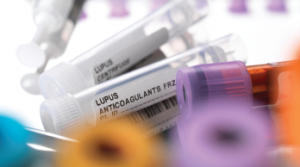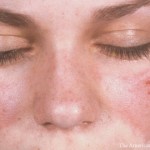
TEK IMAGE / Science Source
AMSTERDAM—Newly proposed systemic lupus erythematosus (SLE) classification criteria and new findings on SLE pathogenesis are two ways in which researchers and clinicians are getting a better grasp on the heterogeneous disease. The criteria and findings were discussed this June in a session at EULAR: the Annual European Congress of Rheumatology.
‘Paradigm Shift’
Sindhu Johnson, MD, PhD, director of the University of Toronto Scleroderma Program, unveiled new lupus criteria—supported, but not yet endorsed, by the ACR and EULAR. The process, largely designed to improve classification of early cases, was the most comprehensive for a set of lupus classification criteria and intended to produce “worldwide consensus,” Dr. Johnson said.
As entry criteria, the system includes an anti-nuclear antibody (ANA) titer of 1:80. From there, the criteria are grouped into seven clinical domains (constitutional, cutaneous, arthritis, neurologic, serositis, hematologic and renal) and three immunologic domains (antiphospholipid antibodies, complement proteins and highly specific antibodies). A score of 10 or more is enough to classify a patient as having SLE.
The criteria are weighted, with scores for each ranging from two for fever, etc., to 10, for Class III or IV lupus nephritis, meaning this criterion alone would be sufficient for a lupus classification.

Dr. Johnson
According to Dr. Johnson, the process was designed to synthesize the collective knowledge of the world’s leading lupus clinicians into a usable format. “The clinical manifestations vary considerably,” she said. “Our ability to make a diagnosis is really based on the physician’s experience and education.”
The weighted score for each criterion was crafted through a painstaking process. Experts were faced with pairs of criteria and repeatedly chose which ones would most likely indicate a lupus classification. The system was validated using cases and controls submitted by international lupus centers. Cases and controls were retained only after agreement by three outside centers that they were in fact cases or controls.
Testing in the 1,001-patient derivation cohort produced a 98% sensitivity rate and a 97% specificity rate. The validation test, with a cohort of 1,270 patients, had 96.1% sensitivity and 94.4% specificity, which compares with 82.8% sensitivity and 93.4% specificity for the 1997 ACR classification criteria and 96.4% sensitivity and 84.5% specificity for the 2012 Systemic Lupus International Collaborating Clinics (SLICC) criteria.
“We found very reasonable sensitivity and specificity, especially when compared against previous iterations of classification criteria,” Dr. Johnson said. She indicated the criteria “represent a paradigm shift in the classification of SLE and provide a new foundation for SLE research.”
‘As we think boldly, now, about lupus pathogenesis & where we should be putting our attention, we really have to focus on the downstream impacts of cellular activation,’ Dr. Daikh said.
Research on SLE
Researchers have discovered important details about the pathogenesis of lupus in recent years that could help lead to more effective therapy, said David Daikh, MD, PhD, president of the ACR and rheumatology chief at the San Francisco Veterans Affairs Medical Center.
In recent findings, researchers showed that interferon-alpha enhances interleukin (IL) 6 production in neutrophils that are stimulated with a toll-like-receptor (TLR) 8 agonist. They also showed that neutrophils from lupus patients with active disease produced increased amounts of IL-6 and TNF-alpha in response to the TLR8 agonist.1
Investigators also highlighted how neutrophil extracellular traps (NETs) contribute to a cycle of inflammation in lupus. NETosis—the cell death process that ends with the springing of these chromatin traps to entangle bacteria—relies on the oxidation of cells. Recently, researchers have shown that these NETs in lupus contain oxidized mitochondrial DNA, which induces inflammatory cytokines.2
Other research has found oxidative stress brings about clustering of mitochondrial antiviral signaling proteins, part of the innate immune defense against viruses, which drive interferon production. This finding raises the possibility of using antioxidant therapy for lupus, Dr. Daikh said.3
Elsewhere, researchers recently identified three variants of the ITGAM gene, which encodes CD11b, that are linked with elevated levels of interferon in lupus. This finding suggests a direct link between CD11b activity and chronic inflammation in the disease.4
Little by little, these insights are revealing why the disease is so heterogeneous: There are many points at which the inflammatory process can malfunction. Dr. Daikh said these findings are taking lupus research in the right direction.
“As we think boldly, now, about lupus pathogenesis and where we should be putting our attention, we really have to focus on the downstream impacts of cellular activation,” Dr. Daikh said. “It’s very hard to prevent all infections. Our lupus patients will be confronted by various viral and bacterial infections, … and so we have to think downstream of those initial signals in terms of modulating activating signals in the adaptive response.
“The ultimate goal would be to be able to tailor specific targeted therapy with individuals who match the heterogeneity that we see—for example, patients who have impaired CD11b function—to provide an effective target for a subset of patients.”
Thomas R. Collins is a freelance writer living in South Florida.
References
- Zimmermann M, Arruda-Silva F, Bianchetto-Aguilera F, et al. IFNα enhances the production of IL-6 by human neutrophils activated via TLR8. Sci Rep. 2016 Jan 21;6:19674.
- Lood D, Blanco LP, Purmalek MM, et al. Neutrophil extracellular traps enriched in oxidized mitochondrial DNA are interferogenic and contribute to lupus-like disease. Nat Med. 2016 Feb;22(2):146–153.
- Buskiewicz I, Montgomery T, Yasewicz E, et al. Reactive oxygen species induce virus-independent MAVS oligomerization in systemic lupus erythematosus. Sci Signal. 2016 Nov 29;9(456):ra115.
- Faridi MH, Khan SQ, Zhao W, et al. CD11b activation suppresses TLR-dependent inflammation and autoimmunity in systemic lupus erythematosus. J Clin Invest. 2017 Apr 3;127(4):1271–1283.

